Snorkeling and Diving in Iceland - Your Guide
Discover the best Iceland snorkeling and scuba diving sites with our ultimate guide to Snorkeling and Diving in Iceland.
5. september 2022
Snorkeling and Diving in Iceland - Your Guide
Discover the best Iceland snorkeling and scuba diving sites with our ultimate guide to Snorkeling and Diving in Iceland.
5. september 2022
The sub-aquatic world of Iceland’s seas, lakes, rivers and water-filled fissures takes the snorkeler and scuba diver to another dimension; a place where you can escape the noise and bustle of the terrestrial world. Underwater, it feels as if time has been suspended. You feel as if you have the weightlessness of a space walker. Other times, you have the sensation of flying. As you snorkel or dive, you become absorbed in the here-and-now. You find yourself in a dream-like state, engrossed by an unfamiliar and thrilling environment. Nothing else matters. Nowhere else exists. The underwater explorer feels all at once in their element and out of their element. Join snorkeling & scuba diving tours and find out why divers become obsessed with the unique and wonderful underworld of Iceland’s waters.
Scuba Diving in Iceland
Why is snorkeling and scuba diving so exciting in Iceland? It’s because you’ll enter an ethereal sub-terrestrial world of river, lake and ocean. In Icelandic waters, you’ll find strange and curious marine life - the most colourful and fanciful creatures of the living world. Swim among alien-looking fish, an array of molluscs and shellfish and pastel-coloured sea anemones. Encounter dolphins and whales as you head out to sea and dive with Iceland’s seabirds. Experience the shipwrecks that lie off Iceland’s coasts and the great bones of our largest sea mammals, the remains of Iceland’s whaling industry. Uniquely in Iceland, you’ll encounter colourful volcanic sands, strange lava formations and even a crater underwater; hot springs, hydrothermal chimneys and, most magical of all, the Mid-Atlantic rift where two continents meet.
Snorkeling in Iceland
Don’t worry if you haven’t snorkelled with a drysuit. If you’re inexperienced, you can join a tour with a guide. The tour operator will provide high-quality and effective equipment for the cold water and they’ll train you up to snorkel underwater while keeping you safe at all times.
Essential equipment for snorkeling and scuba diving in Iceland
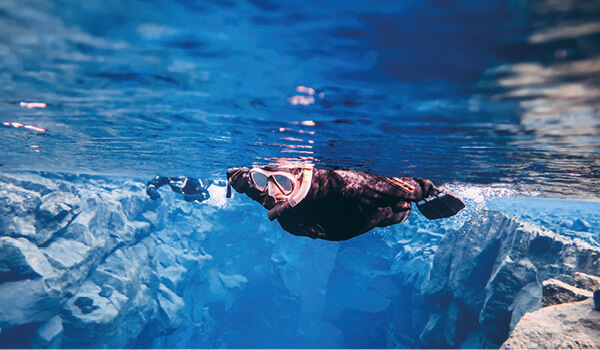
Most of Iceland’s waters are very cold and you will need a thick waterproof drysuit in order to keep warm and dry. Along with the suit you’ll need goggles, flippers, breathing pipe, and neoprene hood and gloves. Under the drysuit you’ll need to wear thermal underwear - long johns and long-sleeved vests as well as warm socks, probably two pairs to be comfortable. Close fitting leisure wear is also suitable. Joggers, leggings and sweatpants all work with a thin sweatshirt. You could even consider two layers under your drysuit.
For scuba diving, you need:
• Diving/drysuit certification
• An air cylinder
• Regulator
• Buoyancy Control device, regulator set and scuba tanks
• Mask, fins and drysuit
It’s best to join a tour where all equipment is provided and meets the highest safety standards.
Silfra Fissure diving and snorkeling site: dive between the continents
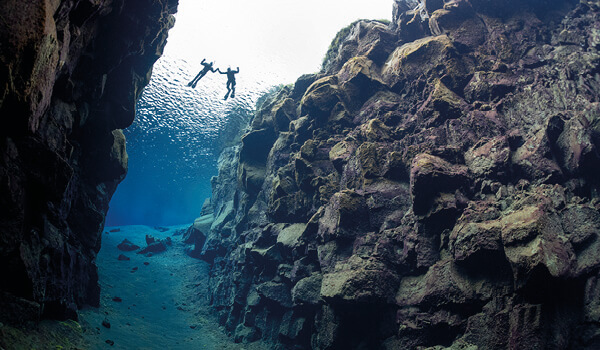
Silfra Fissure is listed in the world’s top ten dives because of its accessible underwater rift and glacial-blue meltwaters. The rift formed in the Mid-Atlantic Ridge where the Eurasian and North American tectonic plates are slowly drifting apart at an approximate rate of 2.5cm a year. With this rate of divergence, you’ll not notice any movement as you snorkel or dive! Head under the water, or your body fully submerged, you’ll literally find yourself at the dividing point between two continents.
Stretch out your arms in the water and touch cliff walls in both North America and Europe. This geological phenomenon apart, it’s an incredible site. Its shimmering appearance provides an otherworldly feel - Silfra means silvery. This is the result of an 18th century earthquake that opened up several fissures in the area. Silfra is the only one to be filled with the glacial meltwaters of nearby Langjökull. As a result, the dive site lays claim to the clearest freshwater in the world with a visibility of up to 100 metres. Marvel at the intense sapphire-blue waters and the vivid green of the long wavy algae Icelanders name ‘Troll’s Hair’. Make your way through the rock-strewn lava field and explore Silfra Hall, the cave system, Silfra Cathedral and the lagoon.
Where is Silfra Fissure?
You’ll find Silfra Fissure in Thingvellir National Park, less than an hour away from Reykjavik. You can see the Mid-Atlantic rift both above and under the water. Thingvellir National Park is one of the wonders of the natural world. Surrounding it are other geological highlights, including Gullfoss Waterfall and Geysir Geothermal Park. Why not take a tour with Reykjavik Excursions and visit the awe-inspiring landmarks of the Golden Circle. Find out why you shouldn’t miss the tour - combined with a once-in-a-lifetime snorkel or dive in Silfra Fissure - in our ultimate guide to the Golden Circle in Iceland.
Take a trip to Thingvellir National Park with Reykjavik Excursions and snorkel in Iceland’s incredible Silfra Fissure where two tectonic plates diverge. For the adventurous, there’s a thrilling freedive scuba tour.
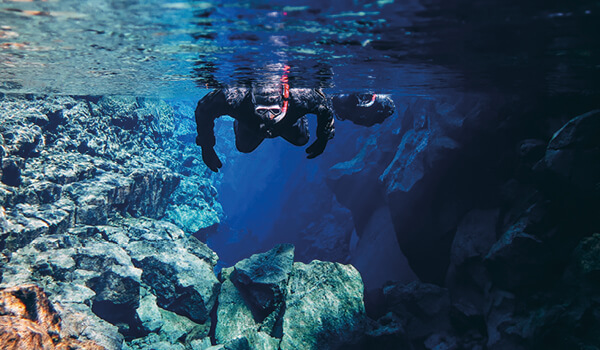
Can I snorkel in Silfra?
Yes you can snorkel in Silfra but not on your own if you’re inexperienced and don’t own safety-standard equipment. It’s best to join small tour groups with experienced guides who will provide you with all the snorkeling equipment you need. You’ll be shown how to put on your drysuit - not the easiest job in the world - and they’ll take you through the guidance to ensure you have a safe snorkel. This is an experience anyone who is relatively fit and healthy can try. Your guides will then talk you through the geology and geography of SIlfra before you get going but they’ll always be at hand in the water if you need assistance.
Is snorkeling in Silfra difficult?
Even if you have never been snorkeling before, you can experience Silfra as a complete beginner. Potentially, you could even try it as a non-swimmer as the drysuit keeps your body afloat on the surface of the water. Having said that, it's reassuring to have some basic swimming skills which will help you manipulate your movements and turn. Once in the water, you’ll soon get to grips with the unfamiliar gear. As soon as you put your head under the water and gently float, you’ll forget everything but the hidden world beneath the surface.
Can anyone dive in Silfra?
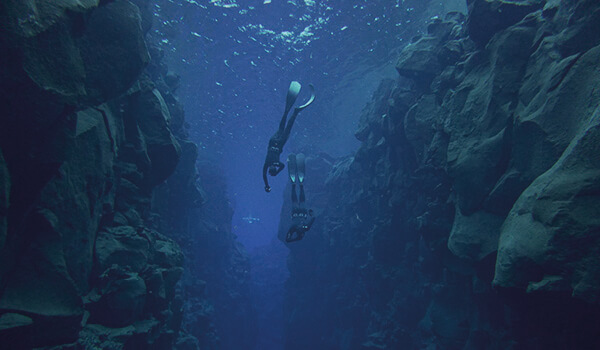
Diving is much more difficult than snorkeling and only those with significant experience can dive here. You must:
• be at least 18 years old and understand instructions in English.
• have an Open Water and Dry Suit certification or Open Water Certification and a logbook with 10 logged drysuit dives in the last two years.
• provide a health certificate if you’re over 60 years old.
Also check out the medical conditions under which you should not dive.
Snorkeling in Iceland - advice
• Never snorkel alone - go with a buddy
• If snorkeling in the sea, be careful of currents and riptides and surging surf on rocks. Check weather conditions first and enter from a sandy beach.
• Avoid snorkeling at dawn or dusk and dark, overcast conditions.
• Don’t touch marine life
• Make sure your drysuit and equipment meet safety standards
• Learn how to remove water from your mask and defog it
• Unless you are very experienced, go on a snorkeling tour with a guide
How deep is the Silfra crack?
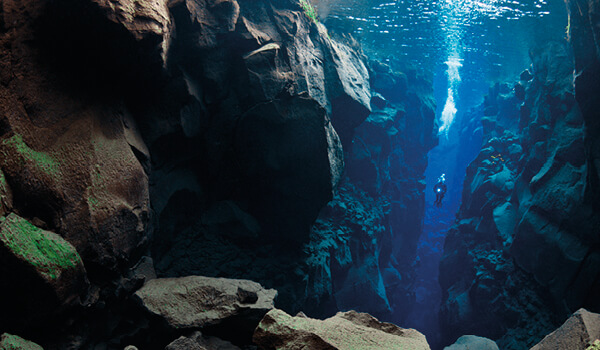
At its deepest Silfra is 60m deep. However, divers are not allowed to descend deeper than 18 metres. Most dives are around ten metres.
How cold is the water in Silfra?
Around 2-4°C year-round. Although cold, it’s a surprisingly comfortable temperature with the aid of a thick drysuit.
Snorkeling and scuba diving tours in Silfra
Join Reykjavik Excursions for an unforgettable snorkeling trip and discover the intensely clear glacial waters of the fissure with up to 100-metre visibility. On this trip you’ll be able to touch the sides of both European and North American tectonic plates at the same time - only possible in Iceland. And if you dare, you can experience the Free-dive Tour; dive down through the fissure as far as you can without breathing equipment.
Other popular Snorkelling and Diving sites in Iceland
Kleifarvatn
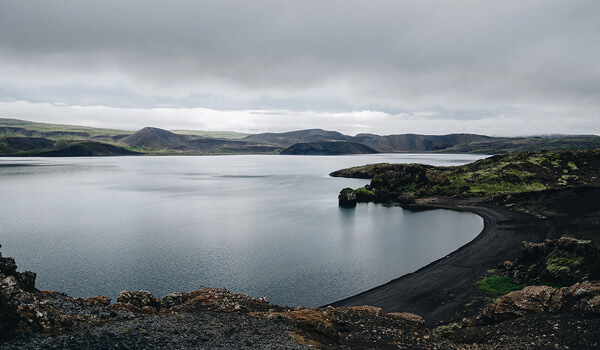
Just a half hour’s drive from the capital, you’ll find Kleifarvatn on Reykjanes, the largest lake on the peninsula. It sits directly on top of the Mid-Atlantic Ridge. For divers a magical volcanic landscape of brightly coloured hills and strange lava formations await you. Offshore, to one side of the lake, there are hot springs with a large crater at its centre. The gases cause the warm water to bubble and the surrounding rocks to vibrate - a strange sensation for the diver. We recommend our partners Dive.is who offer a “Private diving day tour” in either Kleifarvatn or Silfra.
Bjarnagjá
Not far from Garður and the Blue Lagoon, you can combine three incredible water experiences on the Southern Peninsula. The Mid-Atlantic rift, here just a few hundred metres from the sea, is filled with fresh glacial water mixed with saltwater. Bjarnagjá - ‘Barney’s Crack’ - has been used as an atmospheric film location with its old crabbing station, rundown buildings and eerie underworld. Leap into the water and dive down to the fissure, 20m at its deepest. The vertical fissure walls, covered in green-brown algae, drop down to the silted floor scattered with industrial scrap. Check out the small overhead cavern at one end and beautiful pink sea anemones. Keep an eye out for flatfish, crabs and shrimps among the rocks.
Davíðsgjá
Join the trout to explore Davíðsgjá, meaning ‘David’s fissure’. At Thingvallavatn, part of the lake situated inside Thingvellir National Park, you can walk straight into the shallow water and swim until you reach the long, narrow fissure. At its deepest point the opening is 21 metres, its top seven metres below the surface of the water. Marvel at the rocky cliffs and great rubble piles of stone and experience Silfra’s wilder, darker sibling, as the locals like to describe Davíðsgjá. Book a trip with “Davíðsgjá dive tour”.
Garður
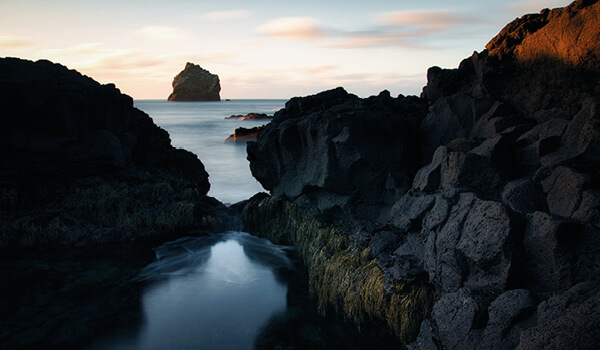
Easily accessed from Reykjavik, Garður is located on the Southern Peninsula of southwest Iceland. Find an underwater world of gardens, deserts and forests. Garður means ‘Garden’, and what a garden it is! There are over 42 species of algae underwater. You could also say it’s a ‘kitchen garden’ as the algae is an ancient food consumed by Icelanders since they first settled on the island. Swim through ethereal kelp forests where wolf fish, catfish and monkfish lurk in the waters. Look out for flatfish that bury themselves in the sandy ‘deserts’ with just their watchful eyes protruding. The beauty of this underwater garden dive site is you can easily access it from a ladder on the pier. Look into the possibility of diving at Garður with Dive Iceland on their Ocean Diver Day Tour.
Litlaá
Underwater exploration doesn’t have to mean freezing-cold temperatures, even in Iceland - well, especially in Iceland! This geothermal river lies west of Skjálftavatn, a lake inland from Iceland’s northeast coast. Litlaá means ‘Little River’, the 17°C shallow waters perfect for snorkelers. The river is a geologist’s and underwater photographer’s dream, the algae on the bed of Litlaá a canvas of yellow and brown hues; volcanic sands rippling out along Litlaá’s riverbed. The multi-coloured sediment and ever-shifting patterns, created by the geothermal eruptions, feels like a psychedelic hallucination.
Nesgjá
The fissure, sometimes called the Silfra of the North, is situated in northern Iceland near Húsavík and Ásbyrgi . Here you can experience tectonic plates first hand. The shallow crack in the earth is only 3-5 metres deep but extends a distance of 150m. The porous lava rock filters the water to create crystal-clear waters, allowing the snorkeller and diver to see up to 100m and sometimes beyond. The fissure is incredibly beautiful with the vivid blues of the water and vibrant greens of the algae-covered volcanic rock. Look out for the sullen-looking Arctic char.
Strýtan
Experience the diving sites of Eyjafjörður, one of Iceland’s longest fjords, north of Akureyri. Arnarnesstrýtan is only a five-minute ride by zodiac from Strýtan Dive Centre, where you can dive to three hydrothermal chimneys - two of them an impressive 45m tall. The tallest one is only 15m below sea level - perfect for scuba diving. Hot water streams from the stacks at a temperature of 75°C. Not only are the chimneys fascinating; the dive sites are also great for sea life. Keep your eyes open for colourful nudibranch - the ‘naked’ or shell-less molluscs - and fearsome-looking Atlantic wolf fish. The cracks and crevices of the chimneys are teaming with wildlife.
Westfjords
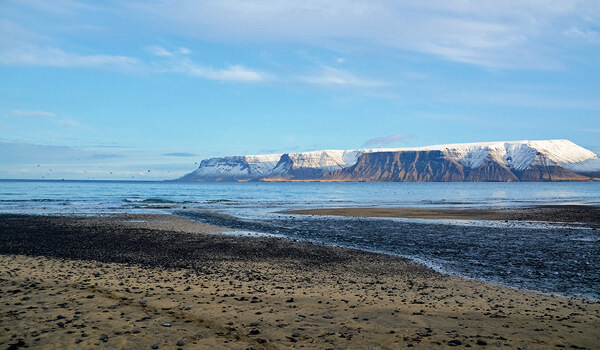
The clear Atlantic waters off the Westfjords, a wild and dramatic peninsula of steep cliffs and pale sands in northwest Iceland, hide numerous wrecks and shipping artefacts. At Álftafjörður and Seyðisfjörður fjords, you can uncover the whaling massacre of the 1800s, the ocean floor littered with the bones of the great sea mammals. The many fjords on the peninsula are rich in wildlife. Look out for living whales and dolphins on the approach to the dive sites. Dive with cormorants, guillemots and razorbills. Keep your eyes open for monkfish and experience Iceland’s only hard coral beds.
Why Snorkel & Dive in Iceland?
Apart from the marine life and shipwrecks of the Atlantic, you’ll experience the uniquely volcanic underworld of Iceland’s freshwaters. Silfra is the only place on Earth where you can simultaneously touch the walls of two continents underwater. How’s that for a thrilling experience?
Best time to dive and snorkel in Iceland
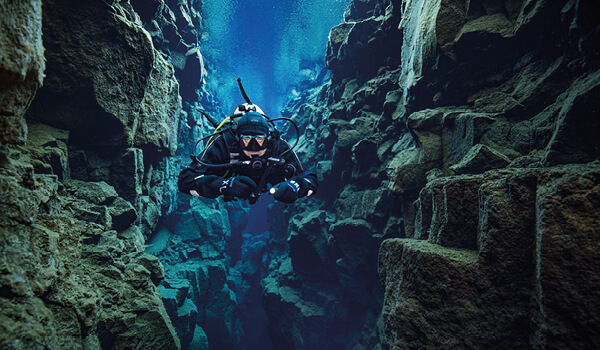
While June to August are the most popular months to visit Iceland due to the long days and relative warmth, you can snorkel or dive in Iceland at any time of year. If you want to combine the northern lights with a snorkel or scuba diving tour, winter is the time to go. You can avoid the summer crowds and snorkel Iceland’s famous fissures, enjoying the wonderful reflections of the surrounding snow-covered landscapes on the water’s still surface on calm, cold days. At Silfra, summer winds cause waves to ripple through the bottom of the rift; a magical experience for the diver. Winter, however, is more challenging in terms of changeable weather conditions and cold. You will need to be hardy. Hop over to The Best time to visit Iceland blog to find out what each month and season has to offer. While some snorkeling and scuba diving tours are limited to the summer months, some are available year-round.
Snorkeling and scuba diving literally open up a whole new world on your Iceland trip. The experiences are as varied as they are exciting. The highlight is undoubtedly Silfra. Book your snorkelling and scuba diving tour in Iceland with Reykjavik Excursions and choose between snorkeling and free-diving in Silfra, or a combined trip exploring a lava tube cave and Silfra Fissure in the national park.
Blogg
Fáðu innblástur! Upplýsingar og góð ráð, áhugaverðir áfangastaðir, skemmtilegar staðreyndar og margt fleira. Bloggið okkar er á ensku en það er stórskemmtilegt engu að síður!
The Silver Circle of West Iceland - Your Guide
You’ve heard of the Golden Circle, but here’s why you should head to Iceland’s western region to explore the msytical Silver Circle tour route.
Lesa bloggSnorkeling and Diving in Iceland - Your Guide
Discover the best Iceland snorkeling and scuba diving sites with our ultimate guide to Snorkeling and Diving in Iceland.
5. september 2022
Snorkeling and Diving in Iceland - Your Guide
Discover the best Iceland snorkeling and scuba diving sites with our ultimate guide to Snorkeling and Diving in Iceland.
5. september 2022
The sub-aquatic world of Iceland’s seas, lakes, rivers and water-filled fissures takes the snorkeler and scuba diver to another dimension; a place where you can escape the noise and bustle of the terrestrial world. Underwater, it feels as if time has been suspended. You feel as if you have the weightlessness of a space walker. Other times, you have the sensation of flying. As you snorkel or dive, you become absorbed in the here-and-now. You find yourself in a dream-like state, engrossed by an unfamiliar and thrilling environment. Nothing else matters. Nowhere else exists. The underwater explorer feels all at once in their element and out of their element. Join snorkeling & scuba diving tours and find out why divers become obsessed with the unique and wonderful underworld of Iceland’s waters.
Scuba Diving in Iceland
Why is snorkeling and scuba diving so exciting in Iceland? It’s because you’ll enter an ethereal sub-terrestrial world of river, lake and ocean. In Icelandic waters, you’ll find strange and curious marine life - the most colourful and fanciful creatures of the living world. Swim among alien-looking fish, an array of molluscs and shellfish and pastel-coloured sea anemones. Encounter dolphins and whales as you head out to sea and dive with Iceland’s seabirds. Experience the shipwrecks that lie off Iceland’s coasts and the great bones of our largest sea mammals, the remains of Iceland’s whaling industry. Uniquely in Iceland, you’ll encounter colourful volcanic sands, strange lava formations and even a crater underwater; hot springs, hydrothermal chimneys and, most magical of all, the Mid-Atlantic rift where two continents meet.
Snorkeling in Iceland
Don’t worry if you haven’t snorkelled with a drysuit. If you’re inexperienced, you can join a tour with a guide. The tour operator will provide high-quality and effective equipment for the cold water and they’ll train you up to snorkel underwater while keeping you safe at all times.
Essential equipment for snorkeling and scuba diving in Iceland

Most of Iceland’s waters are very cold and you will need a thick waterproof drysuit in order to keep warm and dry. Along with the suit you’ll need goggles, flippers, breathing pipe, and neoprene hood and gloves. Under the drysuit you’ll need to wear thermal underwear - long johns and long-sleeved vests as well as warm socks, probably two pairs to be comfortable. Close fitting leisure wear is also suitable. Joggers, leggings and sweatpants all work with a thin sweatshirt. You could even consider two layers under your drysuit.
For scuba diving, you need:
• Diving/drysuit certification
• An air cylinder
• Regulator
• Buoyancy Control device, regulator set and scuba tanks
• Mask, fins and drysuit
It’s best to join a tour where all equipment is provided and meets the highest safety standards.
Silfra Fissure diving and snorkeling site: dive between the continents

Silfra Fissure is listed in the world’s top ten dives because of its accessible underwater rift and glacial-blue meltwaters. The rift formed in the Mid-Atlantic Ridge where the Eurasian and North American tectonic plates are slowly drifting apart at an approximate rate of 2.5cm a year. With this rate of divergence, you’ll not notice any movement as you snorkel or dive! Head under the water, or your body fully submerged, you’ll literally find yourself at the dividing point between two continents.
Stretch out your arms in the water and touch cliff walls in both North America and Europe. This geological phenomenon apart, it’s an incredible site. Its shimmering appearance provides an otherworldly feel - Silfra means silvery. This is the result of an 18th century earthquake that opened up several fissures in the area. Silfra is the only one to be filled with the glacial meltwaters of nearby Langjökull. As a result, the dive site lays claim to the clearest freshwater in the world with a visibility of up to 100 metres. Marvel at the intense sapphire-blue waters and the vivid green of the long wavy algae Icelanders name ‘Troll’s Hair’. Make your way through the rock-strewn lava field and explore Silfra Hall, the cave system, Silfra Cathedral and the lagoon.
Where is Silfra Fissure?
You’ll find Silfra Fissure in Thingvellir National Park, less than an hour away from Reykjavik. You can see the Mid-Atlantic rift both above and under the water. Thingvellir National Park is one of the wonders of the natural world. Surrounding it are other geological highlights, including Gullfoss Waterfall and Geysir Geothermal Park. Why not take a tour with Reykjavik Excursions and visit the awe-inspiring landmarks of the Golden Circle. Find out why you shouldn’t miss the tour - combined with a once-in-a-lifetime snorkel or dive in Silfra Fissure - in our ultimate guide to the Golden Circle in Iceland.
Take a trip to Thingvellir National Park with Reykjavik Excursions and snorkel in Iceland’s incredible Silfra Fissure where two tectonic plates diverge. For the adventurous, there’s a thrilling freedive scuba tour.

Can I snorkel in Silfra?
Yes you can snorkel in Silfra but not on your own if you’re inexperienced and don’t own safety-standard equipment. It’s best to join small tour groups with experienced guides who will provide you with all the snorkeling equipment you need. You’ll be shown how to put on your drysuit - not the easiest job in the world - and they’ll take you through the guidance to ensure you have a safe snorkel. This is an experience anyone who is relatively fit and healthy can try. Your guides will then talk you through the geology and geography of SIlfra before you get going but they’ll always be at hand in the water if you need assistance.
Is snorkeling in Silfra difficult?
Even if you have never been snorkeling before, you can experience Silfra as a complete beginner. Potentially, you could even try it as a non-swimmer as the drysuit keeps your body afloat on the surface of the water. Having said that, it's reassuring to have some basic swimming skills which will help you manipulate your movements and turn. Once in the water, you’ll soon get to grips with the unfamiliar gear. As soon as you put your head under the water and gently float, you’ll forget everything but the hidden world beneath the surface.
Can anyone dive in Silfra?

Diving is much more difficult than snorkeling and only those with significant experience can dive here. You must:
• be at least 18 years old and understand instructions in English.
• have an Open Water and Dry Suit certification or Open Water Certification and a logbook with 10 logged drysuit dives in the last two years.
• provide a health certificate if you’re over 60 years old.
Also check out the medical conditions under which you should not dive.
Snorkeling in Iceland - advice
• Never snorkel alone - go with a buddy
• If snorkeling in the sea, be careful of currents and riptides and surging surf on rocks. Check weather conditions first and enter from a sandy beach.
• Avoid snorkeling at dawn or dusk and dark, overcast conditions.
• Don’t touch marine life
• Make sure your drysuit and equipment meet safety standards
• Learn how to remove water from your mask and defog it
• Unless you are very experienced, go on a snorkeling tour with a guide
How deep is the Silfra crack?

At its deepest Silfra is 60m deep. However, divers are not allowed to descend deeper than 18 metres. Most dives are around ten metres.
How cold is the water in Silfra?
Around 2-4°C year-round. Although cold, it’s a surprisingly comfortable temperature with the aid of a thick drysuit.
Snorkeling and scuba diving tours in Silfra
Join Reykjavik Excursions for an unforgettable snorkeling trip and discover the intensely clear glacial waters of the fissure with up to 100-metre visibility. On this trip you’ll be able to touch the sides of both European and North American tectonic plates at the same time - only possible in Iceland. And if you dare, you can experience the Free-dive Tour; dive down through the fissure as far as you can without breathing equipment.
Other popular Snorkelling and Diving sites in Iceland
Kleifarvatn

Just a half hour’s drive from the capital, you’ll find Kleifarvatn on Reykjanes, the largest lake on the peninsula. It sits directly on top of the Mid-Atlantic Ridge. For divers a magical volcanic landscape of brightly coloured hills and strange lava formations await you. Offshore, to one side of the lake, there are hot springs with a large crater at its centre. The gases cause the warm water to bubble and the surrounding rocks to vibrate - a strange sensation for the diver. We recommend our partners Dive.is who offer a “Private diving day tour” in either Kleifarvatn or Silfra.
Bjarnagjá
Not far from Garður and the Blue Lagoon, you can combine three incredible water experiences on the Southern Peninsula. The Mid-Atlantic rift, here just a few hundred metres from the sea, is filled with fresh glacial water mixed with saltwater. Bjarnagjá - ‘Barney’s Crack’ - has been used as an atmospheric film location with its old crabbing station, rundown buildings and eerie underworld. Leap into the water and dive down to the fissure, 20m at its deepest. The vertical fissure walls, covered in green-brown algae, drop down to the silted floor scattered with industrial scrap. Check out the small overhead cavern at one end and beautiful pink sea anemones. Keep an eye out for flatfish, crabs and shrimps among the rocks.
Davíðsgjá
Join the trout to explore Davíðsgjá, meaning ‘David’s fissure’. At Thingvallavatn, part of the lake situated inside Thingvellir National Park, you can walk straight into the shallow water and swim until you reach the long, narrow fissure. At its deepest point the opening is 21 metres, its top seven metres below the surface of the water. Marvel at the rocky cliffs and great rubble piles of stone and experience Silfra’s wilder, darker sibling, as the locals like to describe Davíðsgjá. Book a trip with “Davíðsgjá dive tour”.
Garður

Easily accessed from Reykjavik, Garður is located on the Southern Peninsula of southwest Iceland. Find an underwater world of gardens, deserts and forests. Garður means ‘Garden’, and what a garden it is! There are over 42 species of algae underwater. You could also say it’s a ‘kitchen garden’ as the algae is an ancient food consumed by Icelanders since they first settled on the island. Swim through ethereal kelp forests where wolf fish, catfish and monkfish lurk in the waters. Look out for flatfish that bury themselves in the sandy ‘deserts’ with just their watchful eyes protruding. The beauty of this underwater garden dive site is you can easily access it from a ladder on the pier. Look into the possibility of diving at Garður with Dive Iceland on their Ocean Diver Day Tour.
Litlaá
Underwater exploration doesn’t have to mean freezing-cold temperatures, even in Iceland - well, especially in Iceland! This geothermal river lies west of Skjálftavatn, a lake inland from Iceland’s northeast coast. Litlaá means ‘Little River’, the 17°C shallow waters perfect for snorkelers. The river is a geologist’s and underwater photographer’s dream, the algae on the bed of Litlaá a canvas of yellow and brown hues; volcanic sands rippling out along Litlaá’s riverbed. The multi-coloured sediment and ever-shifting patterns, created by the geothermal eruptions, feels like a psychedelic hallucination.
Nesgjá
The fissure, sometimes called the Silfra of the North, is situated in northern Iceland near Húsavík and Ásbyrgi . Here you can experience tectonic plates first hand. The shallow crack in the earth is only 3-5 metres deep but extends a distance of 150m. The porous lava rock filters the water to create crystal-clear waters, allowing the snorkeller and diver to see up to 100m and sometimes beyond. The fissure is incredibly beautiful with the vivid blues of the water and vibrant greens of the algae-covered volcanic rock. Look out for the sullen-looking Arctic char.
Strýtan
Experience the diving sites of Eyjafjörður, one of Iceland’s longest fjords, north of Akureyri. Arnarnesstrýtan is only a five-minute ride by zodiac from Strýtan Dive Centre, where you can dive to three hydrothermal chimneys - two of them an impressive 45m tall. The tallest one is only 15m below sea level - perfect for scuba diving. Hot water streams from the stacks at a temperature of 75°C. Not only are the chimneys fascinating; the dive sites are also great for sea life. Keep your eyes open for colourful nudibranch - the ‘naked’ or shell-less molluscs - and fearsome-looking Atlantic wolf fish. The cracks and crevices of the chimneys are teaming with wildlife.
Westfjords

The clear Atlantic waters off the Westfjords, a wild and dramatic peninsula of steep cliffs and pale sands in northwest Iceland, hide numerous wrecks and shipping artefacts. At Álftafjörður and Seyðisfjörður fjords, you can uncover the whaling massacre of the 1800s, the ocean floor littered with the bones of the great sea mammals. The many fjords on the peninsula are rich in wildlife. Look out for living whales and dolphins on the approach to the dive sites. Dive with cormorants, guillemots and razorbills. Keep your eyes open for monkfish and experience Iceland’s only hard coral beds.
Why Snorkel & Dive in Iceland?
Apart from the marine life and shipwrecks of the Atlantic, you’ll experience the uniquely volcanic underworld of Iceland’s freshwaters. Silfra is the only place on Earth where you can simultaneously touch the walls of two continents underwater. How’s that for a thrilling experience?
Best time to dive and snorkel in Iceland

While June to August are the most popular months to visit Iceland due to the long days and relative warmth, you can snorkel or dive in Iceland at any time of year. If you want to combine the northern lights with a snorkel or scuba diving tour, winter is the time to go. You can avoid the summer crowds and snorkel Iceland’s famous fissures, enjoying the wonderful reflections of the surrounding snow-covered landscapes on the water’s still surface on calm, cold days. At Silfra, summer winds cause waves to ripple through the bottom of the rift; a magical experience for the diver. Winter, however, is more challenging in terms of changeable weather conditions and cold. You will need to be hardy. Hop over to The Best time to visit Iceland blog to find out what each month and season has to offer. While some snorkeling and scuba diving tours are limited to the summer months, some are available year-round.
Snorkeling and scuba diving literally open up a whole new world on your Iceland trip. The experiences are as varied as they are exciting. The highlight is undoubtedly Silfra. Book your snorkelling and scuba diving tour in Iceland with Reykjavik Excursions and choose between snorkeling and free-diving in Silfra, or a combined trip exploring a lava tube cave and Silfra Fissure in the national park.
Blogg
Fáðu innblástur! Upplýsingar og góð ráð, áhugaverðir áfangastaðir, skemmtilegar staðreyndar og margt fleira. Bloggið okkar er á ensku en það er stórskemmtilegt engu að síður!
The Silver Circle of West Iceland - Your Guide
You’ve heard of the Golden Circle, but here’s why you should head to Iceland’s western region to explore the msytical Silver Circle tour route.
Lesa blogg